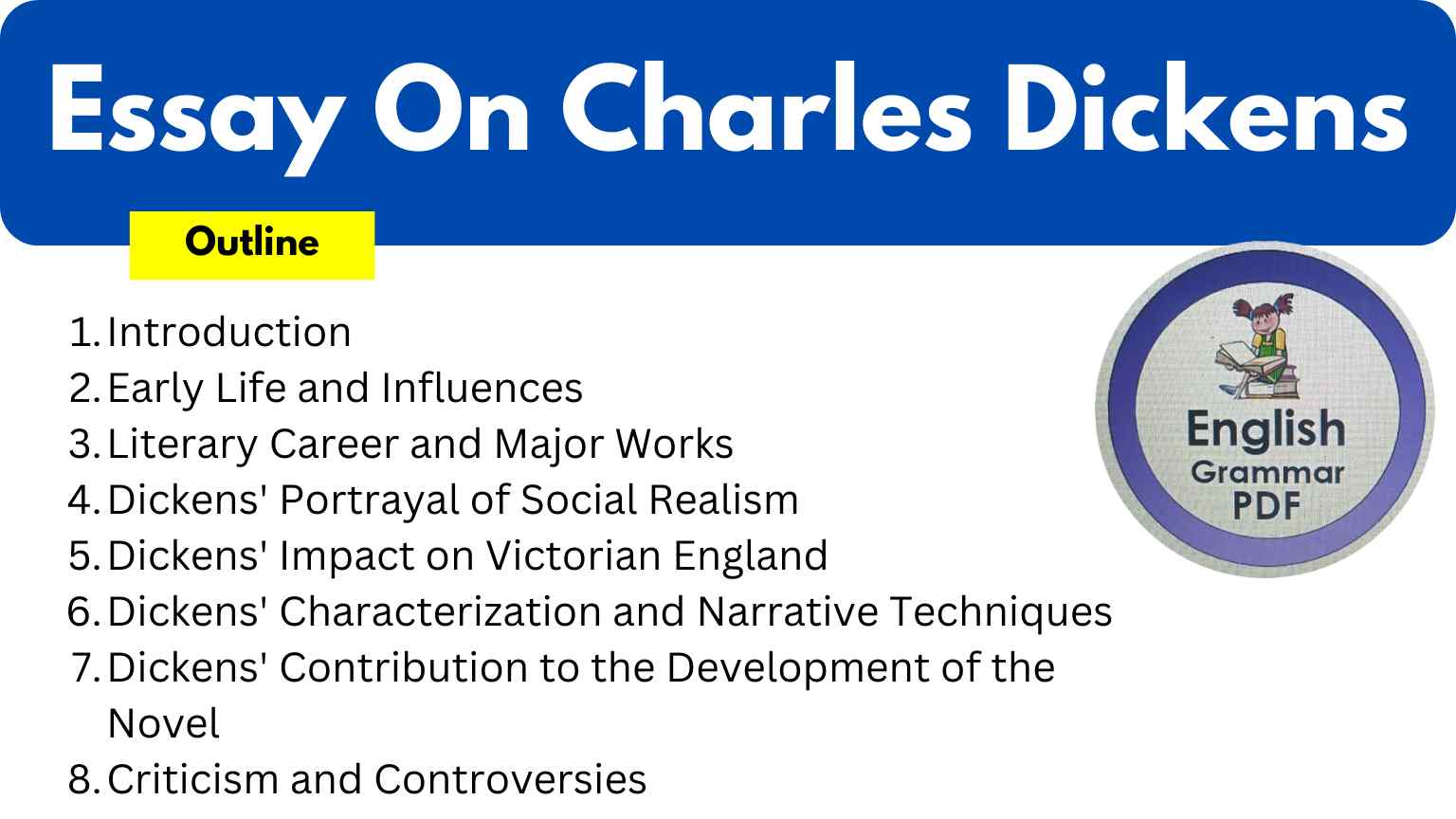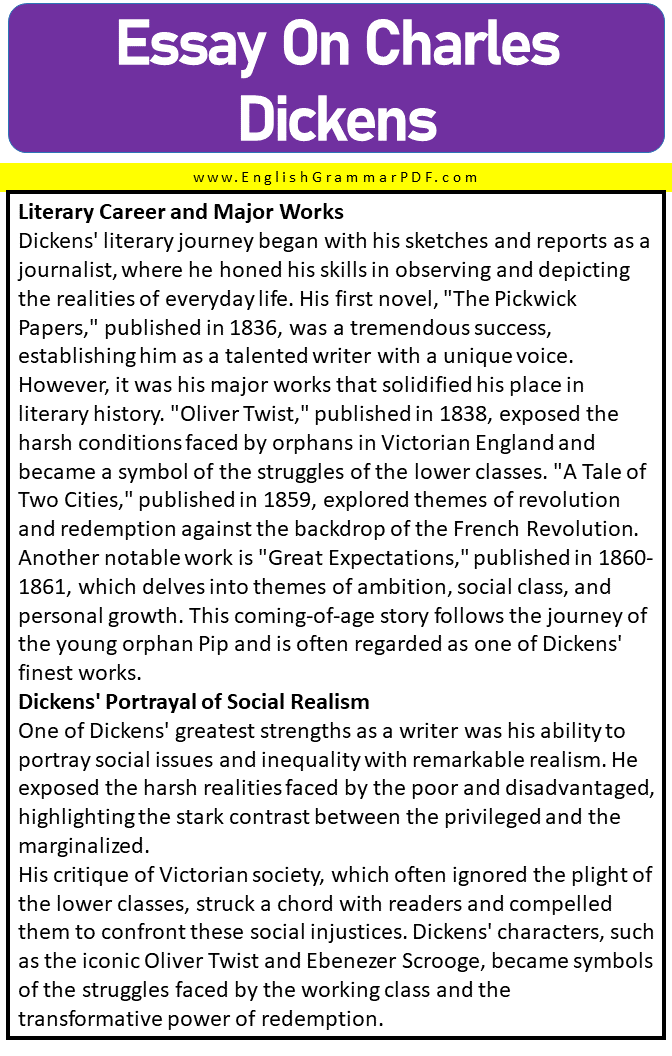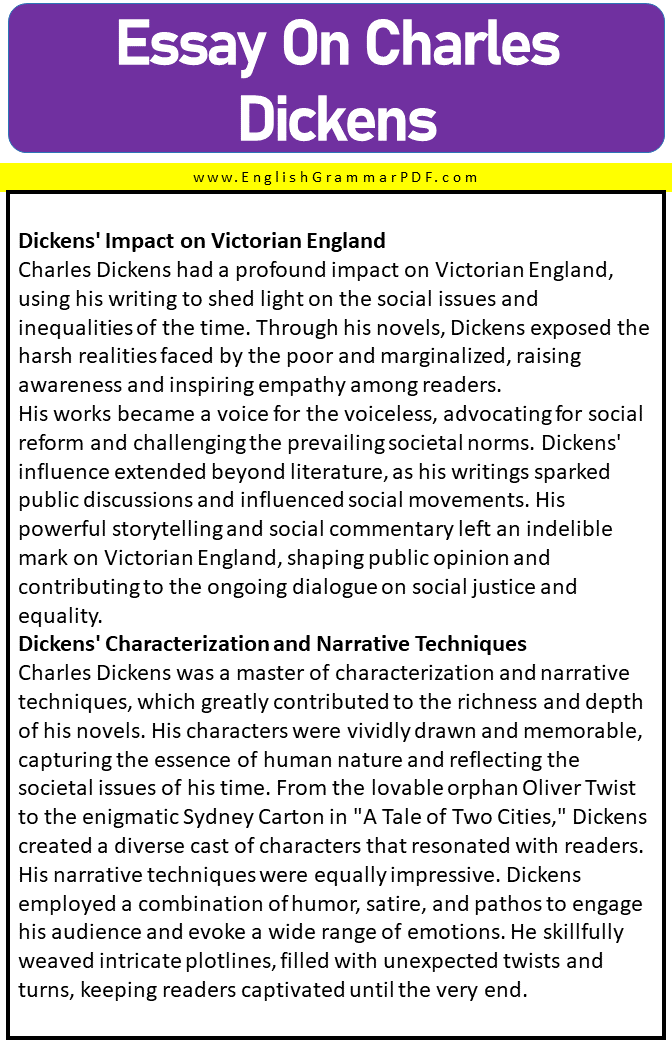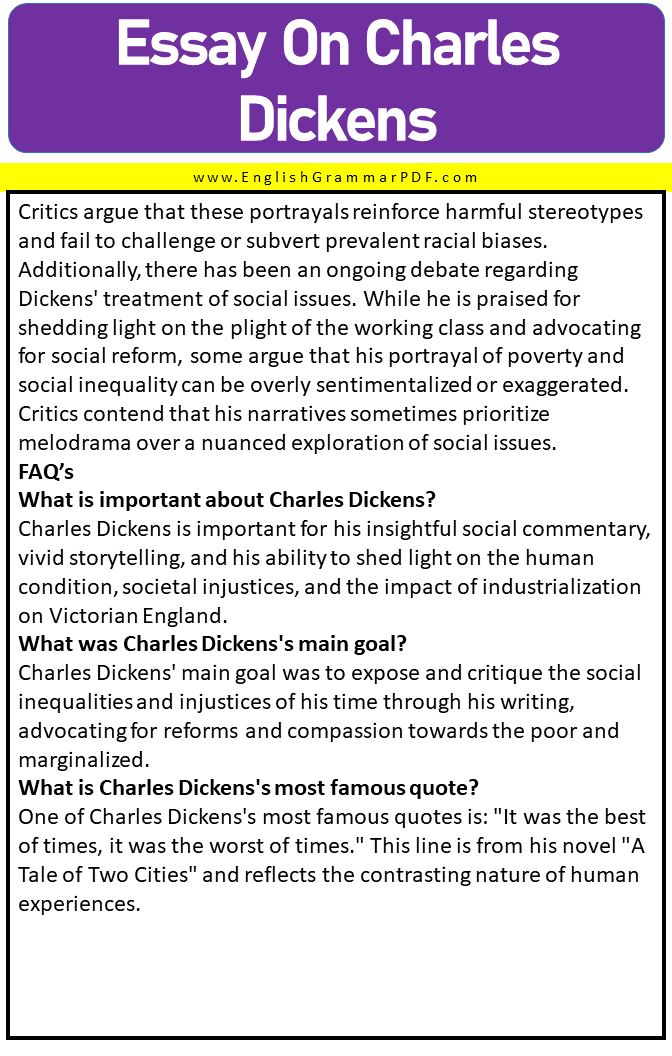Essay On Charles Dickens
Outline of Essay:
- Introduction
- Early Life and Influences
- Literary Career and Major Works
- Dickens’ Portrayal of Social Realism
- Dickens’ Impact on Victorian England
- Dickens’ Characterization and Narrative Techniques
- Dickens’ Contribution to the Development of the Novel
- Criticism and Controversies
Introduction
Charles Dickens is widely regarded as one of the greatest English writers of all time, renowned for his insightful social commentary and vivid storytelling. Born on February 7, 1812, in Portsmouth, England, Dickens had a profound impact on the literary world through his remarkable body of work. His ability to portray the realities of Victorian society, delve into the human condition, and create memorable characters has solidified his place in the literary canon.
Early Life and Influences
Dickens’ childhood was marked by financial difficulties and his father’s imprisonment for debt. These early struggles deeply influenced his perspective and shaped his writing. Despite his limited formal education, Dickens was an avid reader and drew inspiration from various literary sources, including the works of William Shakespeare, Jonathan Swift, and Henry Fielding.
The vivid descriptions of London’s bustling streets, as well as the characters he encountered during his job in a blacking factory, provided him with firsthand experiences that would later find expression in his novels.
Literary Career and Major Works
Dickens’ literary journey began with his sketches and reports as a journalist, where he honed his skills in observing and depicting the realities of everyday life. His first novel, “The Pickwick Papers,” published in 1836, was a tremendous success, establishing him as a talented writer with a unique voice.
However, it was his major works that solidified his place in literary history. “Oliver Twist,” published in 1838, exposed the harsh conditions faced by orphans in Victorian England and became a symbol of the struggles of the lower classes. “A Tale of Two Cities,” published in 1859, explored themes of revolution and redemption against the backdrop of the French Revolution.
Another notable work is “Great Expectations,” published in 1860-1861, which delves into themes of ambition, social class, and personal growth. This coming-of-age story follows the journey of the young orphan Pip and is often regarded as one of Dickens’ finest works.
Dickens’ Portrayal of Social Realism
One of Dickens’ greatest strengths as a writer was his ability to portray social issues and inequality with remarkable realism. He exposed the harsh realities faced by the poor and disadvantaged, highlighting the stark contrast between the privileged and the marginalized.
His critique of Victorian society, which often ignored the plight of the lower classes, struck a chord with readers and compelled them to confront these social injustices. Dickens’ characters, such as the iconic Oliver Twist and Ebenezer Scrooge, became symbols of the struggles faced by the working class and the transformative power of redemption.
Dickens’ Impact on Victorian England
Charles Dickens had a profound impact on Victorian England, using his writing to shed light on the social issues and inequalities of the time. Through his novels, Dickens exposed the harsh realities faced by the poor and marginalized, raising awareness and inspiring empathy among readers.
His works became a voice for the voiceless, advocating for social reform and challenging the prevailing societal norms. Dickens’ influence extended beyond literature, as his writings sparked public discussions and influenced social movements. His powerful storytelling and social commentary left an indelible mark on Victorian England, shaping public opinion and contributing to the ongoing dialogue on social justice and equality.
Dickens’ Characterization and Narrative Techniques
Charles Dickens was a master of characterization and narrative techniques, which greatly contributed to the richness and depth of his novels. His characters were vividly drawn and memorable, capturing the essence of human nature and reflecting the societal issues of his time. From the lovable orphan Oliver Twist to the enigmatic Sydney Carton in “A Tale of Two Cities,” Dickens created a diverse cast of characters that resonated with readers.
His narrative techniques were equally impressive. Dickens employed a combination of humor, satire, and pathos to engage his audience and evoke a wide range of emotions. He skillfully weaved intricate plotlines, filled with unexpected twists and turns, keeping readers captivated until the very end. Dickens also had a knack for incorporating social commentary into his storytelling, using his narratives as a platform to shed light on issues such as poverty, injustice, and class disparity.
Dickens’ Contribution to the Development of the Novel
Charles Dickens played a pivotal role in shaping the development of the Victorian novel. His works revolutionized the genre, introducing innovations in plot structure, character development, and thematic exploration.
Dickens’s novels were characterized by intricate plots, richly drawn characters, and a masterful blend of social commentary and compelling storytelling. His influence extended beyond his own time, inspiring subsequent generations of writers to delve into social issues and craft narratives that resonate with readers.
Criticism and Controversies
Charles Dickens, being one of the most prominent writers of his time, was not immune to criticism and controversies surrounding his works. While he received widespread acclaim for his social commentary and storytelling abilities, he also faced scrutiny and debate on certain aspects of his writing.
One criticism directed at Dickens is his portrayal of women. Some argue that his female characters tend to be one-dimensional and often fall into stereotypes, such as the angelic and passive heroine or the villainous and manipulative woman. Critics argue that these portrayals limit the depth and agency of female characters in his novels.
Another controversy surrounding Dickens’ works is his treatment of racial stereotypes. Some of his characters, particularly those from different racial backgrounds, have been criticized for perpetuating racial stereotypes of the time. Critics argue that these portrayals reinforce harmful stereotypes and fail to challenge or subvert prevalent racial biases.
Additionally, there has been an ongoing debate regarding Dickens’ treatment of social issues. While he is praised for shedding light on the plight of the working class and advocating for social reform, some argue that his portrayal of poverty and social inequality can be overly sentimentalized or exaggerated. Critics contend that his narratives sometimes prioritize melodrama over a nuanced exploration of social issues.
FAQ’s
What is important about Charles Dickens?
Charles Dickens is important for his insightful social commentary, vivid storytelling, and his ability to shed light on the human condition, societal injustices, and the impact of industrialization on Victorian England.
What was Charles Dickens’s main goal?
Charles Dickens’ main goal was to expose and critique the social inequalities and injustices of his time through his writing, advocating for reforms and compassion towards the poor and marginalized.
What is Charles Dickens’s most famous quote?
One of Charles Dickens’s most famous quotes is: “It was the best of times, it was the worst of times.” This line is from his novel “A Tale of Two Cities” and reflects the contrasting nature of human experiences.
Download the PDF of the Essay:
Explore More Essays:








